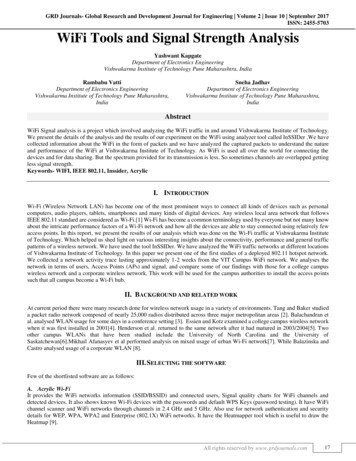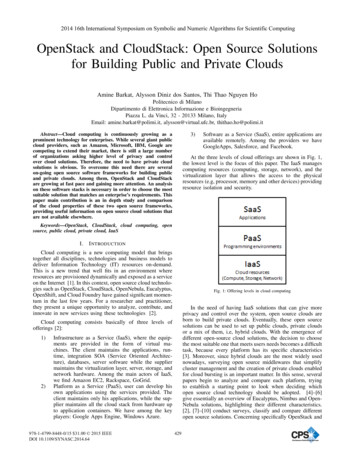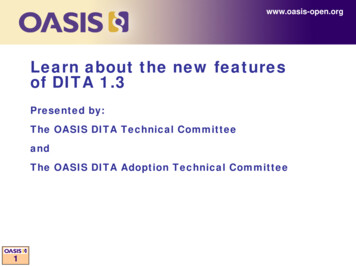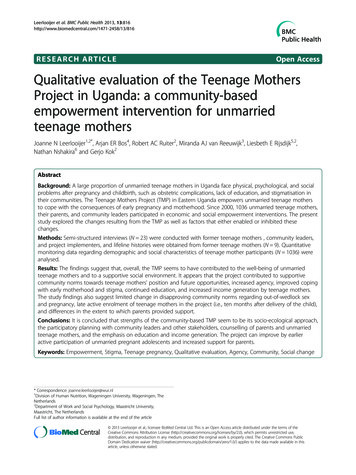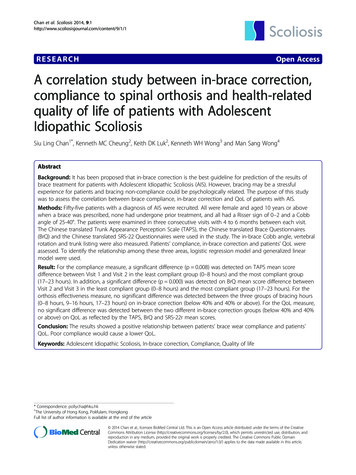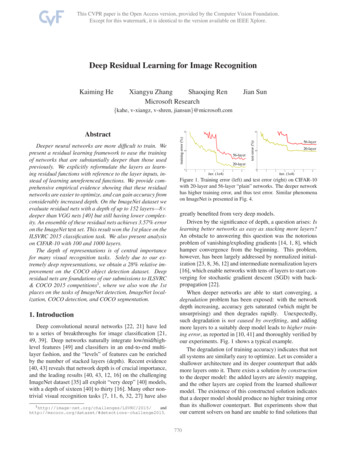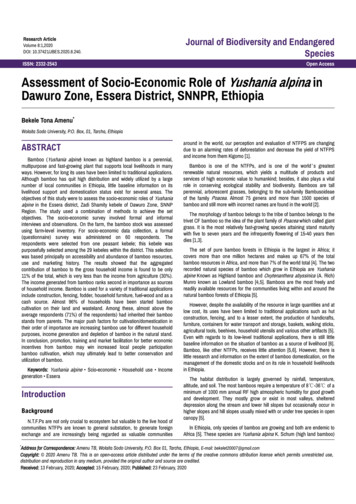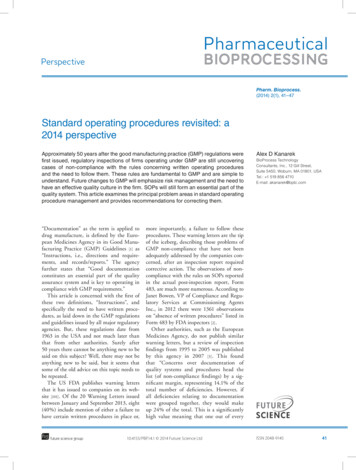
Transcription
PharmaceuticalPerspectivePharm. Bioprocess.(2014) 2(1), 41–47Standard operating procedures revisited: a2014 perspectiveApproximately 50 years after the good manufacturing practice (GMP) regulations werefirst issued, regulatory inspections of firms operating under GMP are still uncoveringcases of non-compliance with the rules concerning written operating proceduresand the need to follow them. These rules are fundamental to GMP and are simple tounderstand. Future changes to GMP will emphasize risk management and the need tohave an effective quality culture in the firm. SOPs will still form an essential part of thequality system. This article examines the principal problem areas in standard operatingprocedure management and provides recommendations for correcting them.“Documentation” as the term is applied todrug manufacture, is defined by the European Medicines Agency in its Good Manufacturing Practice (GMP) Guidelines [1] as“Instructions, i.e., directions and requirements, and records/reports.” The agencyfurther states that “Good documentationconstitutes an essential part of the qualityassurance system and is key to operating incompliance with GMP requirements.”This article is concerned with the first ofthese two definitions, “Instructions”, andspecifically the need to have written procedures, as laid down in the GMP regulationsand guidelines issued by all major regulatoryagencies. But, these regulations date from1963 in the USA and not much later thanthat from other authorities. Surely after50 years there cannot be anything new to besaid on this subject? Well, there may not beanything new to be said, but it seems thatsome of the old advice on this topic needs tobe repeated.The US FDA publishes warning lettersthat it has issued to companies on its website [101] . Of the 20 Warning Letters issuedbetween January and September 2013, eight(40%) include mention of either a failure tohave certain written procedures in place or,future science groupAlex D KanarekBioProcess TechnologyConsultants, Inc., 12 Gill Street,Suite 5450, Woburn, MA 01801, USATel.: 1 519 856 4710E-mail: akanarek@bptc.commore importantly, a failure to follow theseprocedures. These warning letters are the tipof the iceberg, describing those problems ofGMP non-compliance that have not beenadequately addressed by the companies concerned, after an inspection report requiredcorrective action. The observations of noncompliance with the rules on SOPs reportedin the actual post-inspection report, Form483, are much more numerous. According toJanet Bowen, VP of Compliance and Regulatory Services at Commissioning AgentsInc., in 2012 there were 1361 observationson “absence of written procedures” listed inForm 483 by FDA inspectors [2] .Other authorities, such as the EuropeanMedicines Agency, do not publish similarwarning letters, but a review of inspectionfindings from 1995 to 2005 was publishedby this agency in 2007 [3] . This foundthat “Concerns over documentation ofquality systems and procedures head thelist (of non-compliance findings) by a significant margin, representing 14.1% of thetotal number of deficiencies. However, ifall deficiencies relating to documentationwere grouped together, they would makeup 24% of the total. This is a significantlyhigh value meaning that one out of every10.4155/PBP.14.1 2014 Future Science LtdISSN 2048-914541
PerspectiveKanarekfour deficiencies observed relates to a problem withdocumentation.”If one were to assume that all the EuropeanMedicines Agency reports were related to SOPs, thenbetween 24 and 40% of companies currently beinginspected are deficient in their observance of the standard operating procedure (SOP) requirements in therelevant GMP regulations. In my opinion, this topic isdefinitely worth revisiting now.What the rules sayThe creation of SOPs and their observation is mandatory under the GMP legislation. Throughout the textsof the rules, regulations and guidelines published bythe various regulatory authorities appears the requirement that procedures, processes and methods be written down so that comprehensive documentation of themanufacture and testing of a specific drug productexists. An example is shown in Box 1. Note that thisrequirement includes the statement “Written procedures shall be followed ” and that SOPs should bewritten for “ all requirements in this subpart”. The“subpart” referred to is “Subpart F: production andprocess controls.” There are similar requirements inother sub-parts of 21CFR211, referring to the qualitycontrol unit, facilities sanitation, equipment cleaningand maintenance, materials management, the controlof microbial contamination, reprocessing, packagingand labeling control, warehousing and product distribution, laboratory controls, staff training and recordkeeping. The GMP regulations of other regulatoryagencies contain similar lists.The regulatory agencies augment this requirement by specifying that there be a ‘master formula’or ‘master production and testing record’ for eachproduct, documents which will usually contain specific instructions on materials, measurements andprocessing conditions. However, SOPs are requiredfor more than just the drug production and testing.A company that is in full compliance with GMP willhave written procedures for every aspect of its operations that may affect the quality, safety or efficacy ofits products.The SOPs are considered by the regulatory agenciesto be critical GMP documents and as such they areregularly the subject of review by official inspectors.Paul Bellamy, an Investigator for the FDA’s New Jerseydistrict, gave a presentation in which he stated thatSOPs form the starting point for his investigations, asthey provide a blueprint of the firm’s day-to-day operations and show what the firm is documenting and whatit is not [4] . This approach was confirmed by AnneMarie Montemurro, who was a Supervisory ChiefScientific Officer in an FDA Biologics Core Team,when she gave a presentation discussing the TeamBiologics inspection approach [5] . In her presentationshe explained that the risk-based approach to inspections identified the six key facility systems that must beexamined, as shown in Box 2. In each of these systems,there are three critical elements that are common toall biological operations, and which must be inspected.These are SOPs, training and records. SOPs come first.The results of non-complianceA company is well advised to respond as quickly aspossible to the initial observations of potential noncompliance by an inspector, with corrective action thatcan be shown to be effective. If this is not done, or if it isnot done correctly, the next stage may be the issue of anFDA warning letter, or similar action by other regulatoryagencies. This indicates that the firm’s problems withGMP are sufficiently worrying that immediate remediation is needed. Failure to respond to these warnings withplans and commitments that satisfy the agency that theproblems will be promptly corrected may lead to product recalls or court actions that may result in the closureof plants, fines or even imprisonment. As in most cases,prevention of these occurrences is much cheaper thancorrection after the event.Where the problems areDuring his inspections, in common with all inspectors and GMP auditors, Paul Bellamy always reviews acompany’s SOPs in critical operating areas. He stated inhis presentation that, not surprisingly, the problems hefound most often in SOPs were that they were absent,Box 1. US code of federal regulations, 21CFR 211. Current good manufacturing practice forfinished pharmaceuticals. Sec. 211.100: written procedures; deviations.»» (a) There shall be written procedures for production and process control designed to assure that the drugproducts have the identity, strength, quality, and purity they purport or are represented to possess. Suchprocedures shall include all requirements in this subpart. These written procedures, including any changes,shall be drafted, reviewed, and approved by the appropriate organizational units and reviewed and approvedby the quality control unit.»» (b) Written production and process control procedures shall be followed in the execution of the variousproduction and process control functions and shall be documented at the time of performance. Any deviationfrom the written procedures shall be recorded and justified.42Pharm. Bioprocess. (2014) 2(1)future science group
PerspectiveStandard operating procedures revisited: a 2014 perspectiveor they were not followed, or they were not specific. Itis worth examining each of these faults in more detail.»» Lack of critical SOPsLack of critical SOPs is most often reported today ininspections of the quality system. The firm’s qualityculture is now considered to be central to its GMPcompliance. As reiterated in September 2013 by JanetWoodcock, Director of the Center for Drug Evaluationand Research at the FDA, in her keynote address tothe Parenteral Drug Association/FDA joint regulatoryconference [6] , the responsibility for the quality of pharmaceutical products rests with the industry; the agenciesare responsible for ensuring compliance. A lack of clearinstructions in performing the quality unit’s functionsresults in a report like this: “The Quality AssuranceUnit failed to determine that no deviations from SOPswere made without proper authorization and documentation.” The expectations and recommendations for aPharmaceutical Quality System are clearly laid out inthe Guidance Q10 from the International Conferenceon Harmonisation (ICH) [8] . The European MedicinesAgency and the FDA are both committed to the aimsand objectives of ICH and incorporate these guidancesinto their approach to GMP compliance. Failure bya firm to follow Q10’s guidelines will lead to agencyconcerns about its quality system.»» Failure to follow SOPsFailure to follow SOPs is reported for most areas of afacility’s operations, but particularly in manufacturingprocedures, quality control (QC) sampling and testing, and Quality Assurance Unit functions such as theinvestigation of deviations and the corrective and preventive action, which should follow the investigation.Here is a specific example of a warning letter detailinga major manufacturing failure: “The operators at yourfacility have repeatedly failed to comply with your procedures for aseptic operations. Specifically, your operators have been observed to not comply with standardoperating procedure ‘#.’ [specific SOP identifier wasredacted]. Our review indicates that there are on-goingproblems with your personnel failing to comply withprocedures. In your response, you state that your SOPsare inadequate and do not reflect actual practices.”Clearly this is a case where the quality system is inurgent need of improvement.»» Ambiguous SOPsAmbiguous SOPs are a frequent cause of failure to follow the instructions correctly, if at all. If the instructionsare not sufficiently detailed or specific, the SOP cannotbe followed, even by a trained person. Paul Bellamydescribed unsatisfactory “boiler-plate” SOPs that lookedfuture science groupBox 2. Key operating systems identified byrisk-based analysis.»» Quality system»» Materials management system»» Facilities and equipment system»» Production system»» Packaging and labeling system»» Laboratory control systemNote: The quality system is always inspectedOther systems will be inspected according to a prioritylist developed from risk analysesand the results of previous inspectionsas if “they had been downloaded from the internet”. Asa result, a warning letter may state: “We also note thatyour current standard operating procedure, QualityControl Regulation ‘#.’ [specific SOP identifier wasredacted], regarding the responsibilities of the quality unit is inadequate.” Or, “Your firm’s corrective andpreventive action procedure is not adequately defined.”»» SolutionsThe key to compliance in this situation, as with allregulatory compliance, rests with senior management.Unless there is full commitment to a quality missionat the top of the firm, a functioning quality culturewill not be established. GMP regulations require thata quality unit, independent of production and reporting directly to senior management be established, withsufficient staff and authority to ensure the quality ofany product the firm issues for use. It is usual to dividethe functions of the unit into QC and quality assurance (QA). QC is responsible for the testing of rawmaterials, in-process and final drug samples, to ensurethat these comply with pre-set quality specifications. Amajor role of the QA unit is document control, especially the management of SOPs. This function can besplit into several areas of action: creation or amendment, approval, distribution, training and cancellation. The first SOP to be written under this system isthat which lays down rules for each of these activities.»» Creating, approving & distributing SOPsThe European Union’s Eudralex Volume 4 [1] providesbasic GMP guidelines, which include the requirementthat “Instructions and procedures are written in aninstructional form in clear and unambiguous language,specifically applicable to the facilities provided.” Anyoneresponsible for writing these documents must acquirethe necessary skills that ensure that the SOP is readable,accurate, complete and unequivocal. The use of document templates is highly recommended, as these willcreate SOPs with a structure that will become familiarto those affected by the instructions, and ensure that allwww.future-science.com43
PerspectiveKanarekcritical information is included. The outline of a templatefor a production SOP is shown in Box 3. There should bea formal approval process, which is documented on thecover page of the SOP, along with the date on which theSOP will become effective.The best person to write a procedural SOP is someone familiar with the process, preferably an experienced scientist or technician. Here are some simplerecommendations for clear SOP writing:»» The document should be written in simple, plainlanguage. In our multicultural world, English isnow accepted as the principal language for regulatory documentation, but not everyone has Englishas their first language. This fact must be taken intoaccount.»» Always use the active tense: “Add the solution tothe tank”, not “The solution is added ” .»» Avoid lengthy descriptions. If the process includesthe operation of equipment, and the manual foroperating this is available, then the SOP need onlyreference the manual without repeating all theoperating instructions.»» Avoid ‘house jargon’. The SOP must be capable ofinstructing any suitably qualified person, who doesnot need to be familiar with the fact that in thisfacility it has become the habit to refer to a specificprocess by an acronym peculiar to this firm. In fact,it is a good practice to explain all acronyms andabbreviations at the beginning of an SOP, as shownin Box 3.Every section of the SOP template should be completed, unless it is not applicable. The author’s supervisor, or another person in a position of responsibilityin the specific area of operations then checks the draftfor accuracy, completeness, readability and lack ofconfusing instructions. The approved draft is submitted to QA, where it is checked for GMP compliance,and then to the senior quality manager, preferably aVP or equivalent, for authorization to issue. SOPsconcerned with non-production issues, such as generalstaff instructions or training, should be initiated andBox 3. Standard operating procedure template: manufacturing operations.Standard operating procedure: manufacturing operationsCover sheetSOP# XXX.000.00Originated by: Date: Effective: Date:ApprovalsSupervisor: Date:QA manager: Date:Senior management:Date:Revisions#1: By: Date:Supervisor: Date:QA manager: Date:Senior management:Date:Add further revisions, as necessaryFollowing pages: text»» 8.0 Procedure»» 1.0 Title»» 8.1 Safety precautions»» 2.0 Purpose and scope»» 8.2 Special handling procedures»» 2.1 Purpose of procedure»» 8.3 Calibration of equipment»» 2.2 Scope of procedure»» 8.4 Process steps»» 3.0 Responsibilities»» 8.4.1 Step 1»» 3.1 Operator responsibilities»» 8.4.2 Step 2 (and so forth)»» 3.2 Supervisor responsibilities»» 8.5 Data to be recorded»» 4.0 Definitions and acronyms»» 8.6 Samples to be taken, labeling»» 5.0 Principle of procedure (if applicable)»» 9.0 Next processing stage»» 6.0 Reference documents»» 9.1 Description of next stage»» 6.1 Batch record»» 9.2 Storage and labeling of processed lot»» 6.2 Other standard operating procedure»» 6.3 Other process references (e.g., equipment operating »» 10.0 Countersignatures required»» 11.0 Attachments, forms (test request forms,manuals)equipment, printouts, deviation reports, and so on)»» 7.0 Materials and equipment»» 7.1 Previous process stage (characterization)»» 7.2 Chemicals and reagents»» 7.3 Equipment44Pharm. Bioprocess. (2014) 2(1)future science group
PerspectiveStandard operating procedures revisited: a 2014 perspectiveapproved by the responsible department, for example,human resources. All SOPs should pass through the QAsystem. A suggested list of SOPs for a manufacturingfacility is shown in Box 4.There must be a central record of all SOPs, past andpresent, and each document should be identified bya unique alphanumeric code. It is usual to include inthe code two or three letters identifying the affectedfunction, the SOP serial number and a serial numberindicating the version, for example, PRO 103.02,describes the one hundred and third SOP concerningthe production department, in its second version.The information is best kept in a master SOP file, containing the description of each SOP, its effective date andall revisions. Most companies now maintain the masterfile and copies of all SOPs (with their archived earlierversions) as electronic records, which are printed out asneeded. In most cases, the personnel responsible for theactivity now access their SOPs via computer monitors,so that the maintenance of past and current versions canbe done by a central computer. It then becomes essentialto ensure that the computer system complies with thespecific GMP rules governing electronic records, such asEudralex Volume 4, Annex A.11, or the FDA’s 21CFR11.These require that access to the records is controlled by ausername/password or similar security system and thatall activities performed in creating and maintaining therecords are recorded by the computer. This will providewhat is termed an “audit trail”, whereby any change to adocument is permanently recorded and can be accessedby an auditor or inspector.QA is responsible for the distribution of SOPs tothe relative department and for ensuring that only thecurrent version is available, and only to those personsauthorized to access it. If paper copies of the previousversion were issued to the factory or laboratory, thesemust be collected by a QA person and their destructionrecorded. Then it is essential to ensure that the currentSOP can easily be accessed by an operator at the pointof the activity.Always ensure that the files of print-outs of the SOPsthat are made available to inspectors and auditors onlycontain the latest versions. GMP audits of companiesdiscover master files containing hundreds of SOPs, ofwhich up to 30% may be out-dated versions. This doesnot create a good impression. The usual reason givenby a QA manager is that they are planning to reviewthe files, but have not yet got around to it. But, if thesystem is followed, revision of the Master File shouldbe an ongoing activity and should not need a ‘blitz’.»» AmendmentsManaging changes in SOPs should be part of the overall QA change control procedures and there shouldfuture science groupbe written instructions for this. An amendment to aSOP can be made at any time, using a set process thatis documented on forms issued and managed by QA.The form will record the proposed amendment, withjust
BioProcess Technology Consultants, Inc., 12 Gill Street, Suite 5450, Woburn, MA 01801, USA Tel.: 1 519 856 4710 E-mail: akanarek@bptc.com. Perspective 42 Pharm. Bioprocess. (2014) 2(1) o Kanarek four deficiencies observed relates to a problem with

